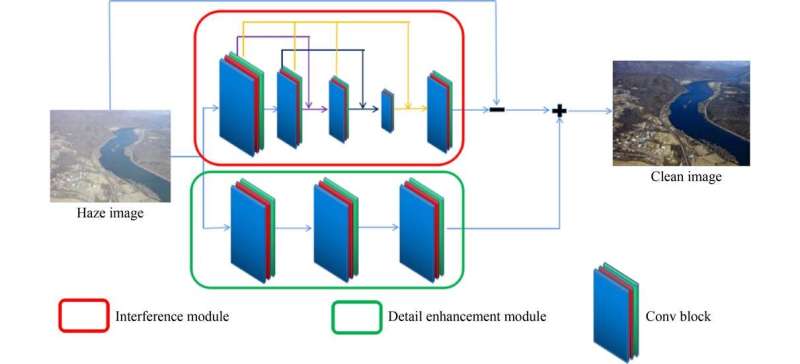This article has been reviewed according to Science X's editorial process and policies. Editors have highlighted the following attributes while ensuring the content's credibility:
fact-checked
proofread
Anti-interference and detail enhancement dehazing network for real-world scenes

The haze phenomenon seriously interferes the image acquisition and reduces the image quality. Due to many uncertain factors, dehazing is typically a challenge in image processing. The existing deep learning-based dehazing approaches apply atmospheric scattering model (ASM), which originally comes from traditional dehazing methods.
However, the data set trained in deep learning does not match well with this model for three reasons. First, the atmospheric illumination in ASM is obtained from prior experience, which is not accurate for dehazing real-scene. Second, it is difficult to get the depth of outdoor scenes for ASM. Third, the haze is a complex natural phenomenon, and it is difficult to find an accurate physical model and related parameters to describe this phenomenon.
To address this challenge, a research team led by Fazhi HE published their new research in Frontiers of Computer Science.
The team proposes a black box method, in which the haze is considered an image quality problem without using any physical model such as ASM. Analytically, the team propose a novel dehazing equation to combine two mechanisms: interference item and detail enhancement item. The interference item estimates the haze information for dehazing the image, and then the detail enhancement item can repair and enhance the details of the dehazed image.
Based on the new equation, an Anti-Interference and Detail Enhancement Dehazing Network (AIDEDNet) is designed, which is dramatically different from existing dehazing networks in that the proposed network is fed into the haze-free images for training. Specifically, a new way to construct haze patch on the flight of network training is proposed. The patch is randomly selected from the input images and the thickness of haze is also randomly set.
In the future, at least four directions will be explored. The first one is to further improve the proposed method with multi-scale and multi-feature convolutional network. The second one is to apply the proposed method to other image processing fields, such as image detraining, image denoising and restoration. The third one is to extend the proposed method to process video dehazing. The fourth one is to extend the proposed idea and approach to 3D data.
More information: Jian Zhang et al, AIDEDNet: anti-interference and detail enhancement dehazing network for real-world scenes, Frontiers of Computer Science (2022). DOI: 10.1007/s11704-022-1523-9


















